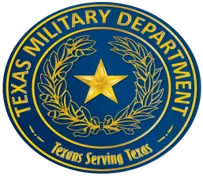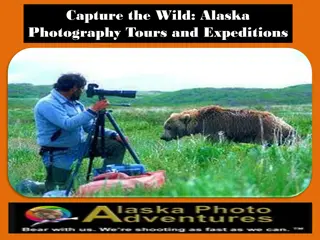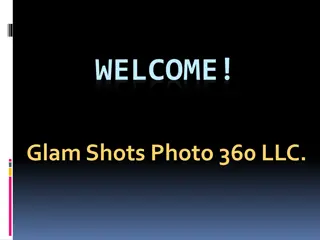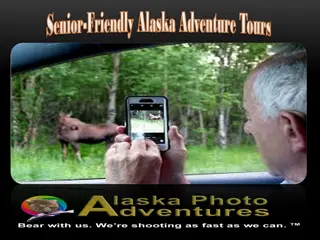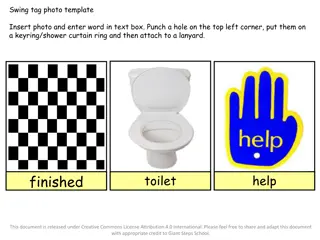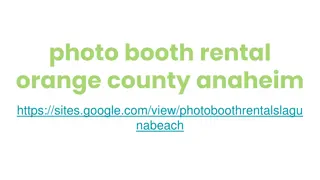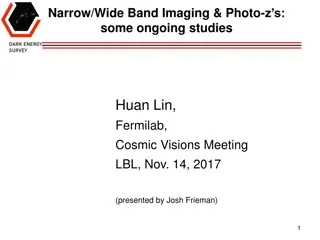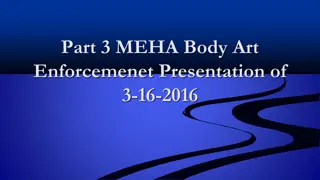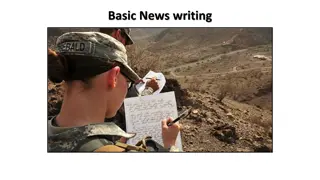Mastering the Art of Effective Photo Captioning for Public Affairs
Learn the essential principles of effective photo captioning from the State Public Affairs Office. Discover the ABCs of captioning - Accuracy, Brevity, and Clarity. Understand the importance of the 5 Ws - Who, What, When, Where, and Why - in crafting informative captions. Find guidance on identifying and describing subjects, actions, and locations in images for improved communication. Enhance your captioning skills for a clear and impactful storytelling experience.
Download Presentation

Please find below an Image/Link to download the presentation.
The content on the website is provided AS IS for your information and personal use only. It may not be sold, licensed, or shared on other websites without obtaining consent from the author. Download presentation by click this link. If you encounter any issues during the download, it is possible that the publisher has removed the file from their server.
E N D
Presentation Transcript
Captioning your photos STATE PUBLIC AFFAIRS OFFICE
Resources http://defenseimagery.mil/dms/dvi-documents/StyleGuide- 131028.pdf http://www.defenseimagery.mil/learning/vision_id.html malcolm.m.mcclendon.mil@mail.mil STATE PUBLIC AFFAIRS OFFICE
The ABCs To write an effective caption, remember the ABCs of captioning Accuracy - Ensure every piece of information within the caption is accurate and complete. Brevity - When writing a caption, be certain every word is necessary to tell the story of the image. Clarity - To be understood by the end user, a caption must be clear in both intent and expression. STATE PUBLIC AFFAIRS OFFICE
The 5 Ws When gathering information to include in a caption, keep the following questions in mind: who, what, when, where and why. Who - who or what is the subject of the image? What - Describe the action captured by the imagery. When - Provide the date and, if pertinent, the time of day when the image was captured. Include the date within the caption. Where - Provide the geographic location as well as the name of the base, facility or organization, if applicable. Why - Explain the purpose of the event, exercise or operation depicted in the image. STATE PUBLIC AFFAIRS OFFICE
Who Who or what is the subject of the image? If the subject of a sentence is a person or persons, provide the rank, first and last name, title and military unit for each person. (e.g., Staff Sgt. Carrie Oakie, Head Urinalysis Tester ) List units from smallest to largest. (e.g., assigned to Charlie Company, 3rd Squadron, 124th Cavalry Regiment, Texas Army National Guard, supervises the urinalysis test at Camp Swift, near Bastrop, Texas, June 7, 2013.) Every effort should be made to identify the subject of a photo. People appearing in the background need not be identified unless they are essential to the story of the image. STATE PUBLIC AFFAIRS OFFICE
What Describe the action captured by the imagery. Use active voice vs. passive voice when describing the action. Active: U.S. Soldiers destroy confiscated ordnance. Passive: Confiscated ordnance is destroyed by U.S. Soldiers. STATE PUBLIC AFFAIRS OFFICE
What Describe the action captured by the imagery. Do not over-describe the action; let the image speak. EXAMPLE: Incorrect: U.S. Air Force Staff Sgt. Warren Peace, right, with the 736th Security Forces Squadron, checks the status of an entry control point using radio communications at Williamson Airfield, Shoalwater Bay Training Area in Queensland, Australia, July 22, 2013. Correct: U.S. Air Force Staff Sgt. Warren Peace, right, with the 736th Security Forces Squadron, checks the status of an entry control point at the Shoalwater Bay Training Area in Queensland, Australia, July 22, 2013. STATE PUBLIC AFFAIRS OFFICE
When Provide the date and, if pertinent, the time of day when the image was captured. Format: Aug. 21, 2011. Spell out months March through July and abbreviate months August through February. (e,g., at Camp Swift, near Bastrop, Texas, June 7, 2013.) or ( at Camp Swift, near Bastrop, Texas, Feb. 7, 2013.) Abbreviate month with date only: Feb. 27, 2011, but February 2011. Use month, day, year format. Do not include on before the date. Do not use the day of the week. STATE PUBLIC AFFAIRS OFFICE
Where Provide the geographic location as well as the name of the base, facility or organization, if applicable. City, State or City, Country No city? State region or general area (e.g., along the Texas-Mexico border) If it is an undisclosed location, state that within the caption and metadata. Do not use the word here in place of a location in a caption. Spell out state names Base with own Zip code = City (Ie. Fort Hood) STATE PUBLIC AFFAIRS OFFICE
Why Explain the purpose of the event or operation depicted in the image. Why does this matter? Command Message BRIEF Second sentence Which is more relevant? Maj. Gen. John F. Nichols, the Adjutant General of Texas, takes time to visit Soldiers from the 454th Engineer Company, 111th Engineer Battalion, Texas Army National Guard, as they prepare to conduct the land navigation portion of their premobilization training at Camp Swift, Texas, Jan. 14, 2013. Maj. Gen. Nichols is the 45th Adjutant General appointed by the Governor of Texas. (U.S. Army National Guard photo by Staff Sgt. Malcolm McClendon/Released). Maj. Gen. John F. Nichols, the Adjutant General of Texas, takes time to visit Soldiers from the 454th Engineer Company, 111th Engineer Battalion, Texas Army National Guard, as they prepare to conduct the land navigation portion of their premobilization training at Camp Swift, Texas, Jan. 14, 2013. The 454th Engineer Company will be deploying to Afghanistan this year, and is the only route clearance mission team within the Texas National Guard. (U.S. Army National Guard photo by Staff Sgt. Malcolm McClendon/Released). STATE PUBLIC AFFAIRS OFFICE
Constructing a caption Traditionally 2 sentences. Can be more than 2 if necessary. 1st: Who, What, Where, When Present Tense Describe image in moment captured 2nd: WHY Past Tense Significant background info Why does the audience care? Command Message or Theme 2nd sentence in this photo could explain why/when military hosts memorial services. Shows theme: Put People First STATE PUBLIC AFFAIRS OFFICE
Additional rules for captioning Spell out words first to introduce acronyms: Joint Base San Antonio (JBSA) Use acronyms on second reference Do not use apostrophes when using a plural acronym. For example: MREs, not MRE s; F-15s, not F-15 s. Avoid the use of jargon. Write for a civilian audience. Do not editorialize. Stick to the facts. Include the photographer s credit and the release status. (U.S. Army National Guard photo by Spc. Bill Miller/Not Released) (U.S. Air National Guard photo by Staff Sgt. Ronald McDonald/Released) STATE PUBLIC AFFAIRS OFFICE
Military Titles Identify military component, position (if important to story), and unit assigned to. Example: Chilean Air Force Capt. Javier Salinas, left, Commandos, 6th Squadron, 4th Aviation Brigade, Chilean Air Force, briefs U.S. Air Force Brig. Gen. Brian Newby, Chief of Staff and Vice Commander, Texas Air National Guard, and Command Chief Master Sgt. Oscar Tey, Senior Enlisted Leader, Texas Joint Domestic Operations Command, on the capabilities of his unit at the brigade's air base in southern Chile, March 27, 2014. The visit was part of the Annual State Partnership Program Planning Meeting, there the leaders discussed, planned and agreed on the security cooperation events that the two organizations will conduct in the next two years. (U.S. Army National Guard photo by Sgt. 1st Class Malcolm McClendon/ Released). STATE PUBLIC AFFAIRS OFFICE
Vision ID naming your files (photos) Identifies the photographer, videographer or graphic artist. All DoD photographers, videographers, graphic artists, photojournalists, broadcasters and public affairs shall be assigned a Vision ID. Go to https://vipro.defenseimagery.mil/ to obtain a vision ID. Example of photo shot on June 10, 2012 is: 120610-Z-PK898-003. 120610 is the year, month and day Z is the letter designation for all National Guardsmen PK898 is the individuals personalized Vision ID (you will have your own) 003 is the sequential order of your photos. They all start at 001. (Three digits no matter how few photos you take.) STATE PUBLIC AFFAIRS OFFICE
Practical exercise Caption the following photo. Here are the facts: Texas Military Forces senior leadership conduct a visit to Chile on March 27, 2014 Chilean Air Force Capt. Javier Salinas is assigned to Commandos, 6th Squadron, 4th Aviation Brigade, Chilean Air Force. Salinas was picked to brief the visitors on the capabilities of his unit at the brigade's air base in southern Chile. The visit was part of the part of the Annual State Partnership Program Planning Meeting. U.S. Air Force Brig. Gen. Brian Newby, Chief of Staff and Vice Commander, Texas Air National Guard, and Command Chief Master Sgt. Oscar Tey, Senior Enlisted Leader, Texas Joint Domestic Operations Command, made the trip on behalf of Texas. Salinas was the first Chilean Airman to receive jump wings from both the U.S. and Germany. STATE PUBLIC AFFAIRS OFFICE



